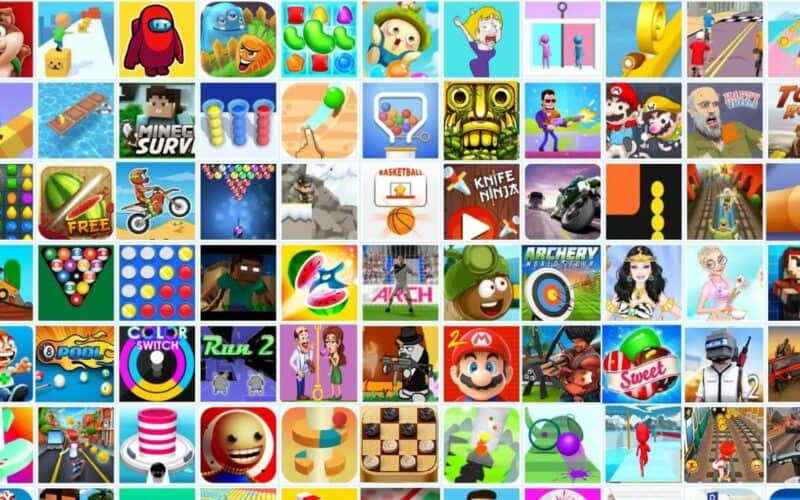Although the world and its economy look like they’re reeling from the pandemic, it’s long understood that its residual effects will keep affecting the world economy for a long time. During the pandemic, the mobile game industry experienced rapid growth that surpassed all predictions because of the countermeasures against the spread of the COVID-19 virus. The most drastic of these measures were lockdowns and other various forms of social distancing. People had to stay in their homes with access to minimal amounts of human interaction. Stuck in their homes, most people found solace in video games as a means to spend time. Mobile games especially capitalized from this period because mobile devices were readily owned by a huge part of the population. But with the pandemic ending, these circumstances were no more, and the industry has declined for the first time. This decline came after an extraordinary period in human history as the market and industry were reaching equilibrium. But let’s face it: until the industry growth finds a balance and returns to its natural track, its stakeholders must adapt to survive this period.
On the bright side, the game industry is one of the industries that has been least affected by this period of crisis, thanks to its inherent nature. It’s free of logistic or workforce limitations. It can adapt to local dynamics faster and better and is practically independent of nations and borders. Considering the world economy is struggling through trade restraints, regional wars, conflicts, and logistical crises, these advantages are true blessings. The puzzle game genre even offers additional advantages besides these. Because of its innate advantages, the puzzle game genre rises like a beacon that will help developers navigate this challenging period, so let’s see why.
Puzzle games revenue statistics
Let’s talk about the money first. According to Statista, in 2022, the puzzle games market is anticipated to achieve a total revenue of $13.45 billion, with projections indicating an annual growth rate (CAGR 2022-2027) of 10.37%. This growth trajectory is predicted to lead to a market volume of $22.51 billion by 2027. In the same year, in-app purchase (IAP) revenue within the puzzle games market is forecasted to reach $5.96 billion, while paid app and advertising revenue are projected at $0.05 billion and $7.44 billion, respectively. The number of downloads in the puzzle games market is estimated to hit $12.60 billion in 2022, with an average revenue per download of $1.07. A global perspective highlights that the United States is the primary revenue generator, contributing $5,517.00 million in 2022.
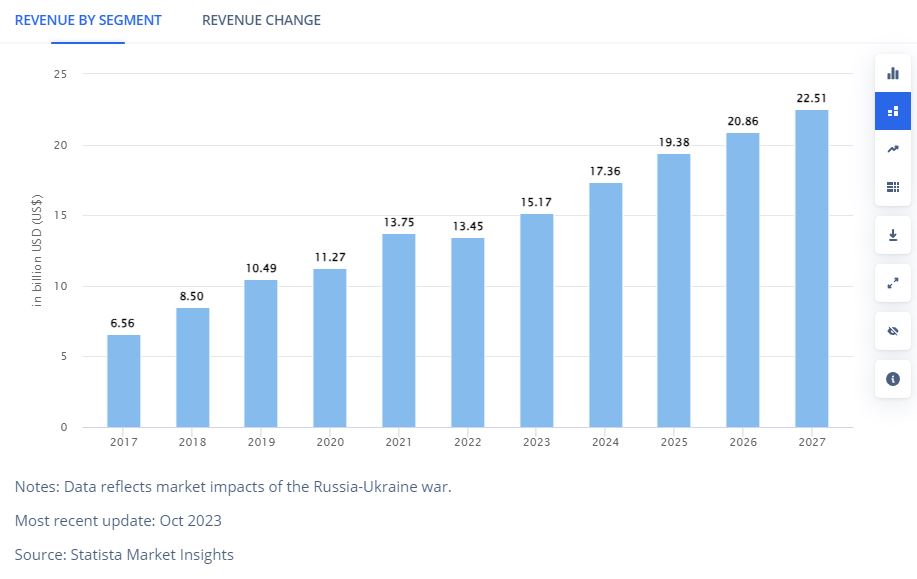
As can be seen in the graph, the future looks brighter for the puzzle game genre. After a sharp drop in segment revenue in 2022, it has been recovering and will continue to increase. This is also reflected in the average revenue per download.
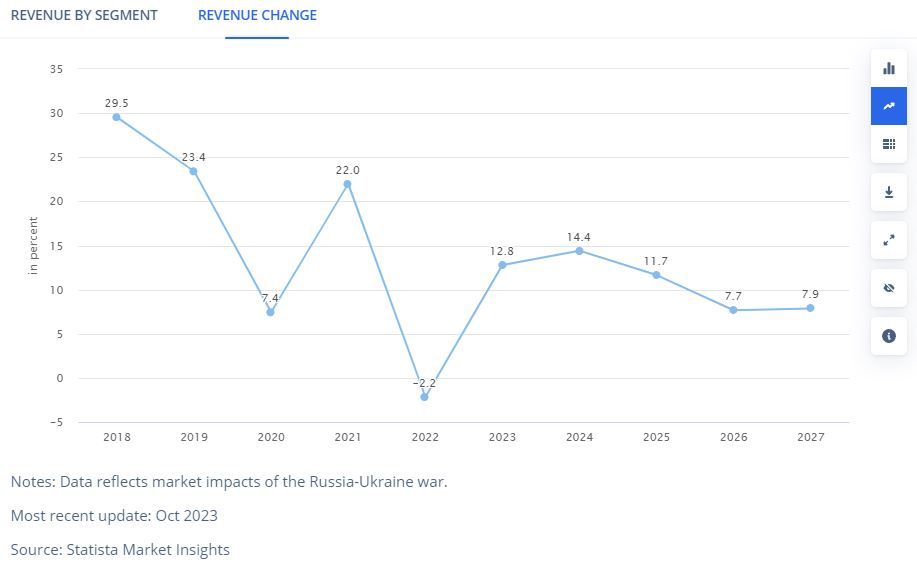
Success stories: Candy Crush, Royal Match
There are also encouraging examples in the genre regarding revenue and profitability. Candy Crush has surpassed a lifetime revenue of $20 billion; other successful examples exist. Royal Match, developed by Turkish game developer Dream Games, seems to be its closest competitor and even dethroned Candy Crush at one point. Considering that the bulk of the revenue of Royal Match is generated in the US, it is encouraging for developers to take their chances on international grounds.

Other encouraging examples in the genre are Toy Blast, Merge Mansion, Fishdom, Homescapes, and Gardenscapes. These are all profitable products of this genre and have been consistently profitable. Below is a table presenting the general data of the top games in the genre in the last two years.

Puzzle games are addictive
Since the time people played Minesweeper on Windows 3.1 on their work computers or locked their eyes mesmerized on Tetris, puzzle games have been an addiction for many because of their distinctive characteristics. They are crafted to offer an experience that is easy to learn and effortlessly enjoyable. With minimal rules and mechanics, puzzle games involve solving puzzles or tackling challenges through straightforward tasks, eliminating the need for extensive prior knowledge or gaming expertise.
Beyond Pastime: Puzzle game enthusiasts define themselves as gamers
Another key trait is the shortness of rounds and gaming sessions. Puzzle games are designed for quick, on-the-go entertainment, with gameplay structured to be completed within a few minutes or less. This attribute attracts people seeking brief, fun relaxation during short breaks or commutes. The convenience of these brief sessions makes puzzle games an attractive option for players desiring instant amusement without the commitment of a prolonged gaming experience.
Nonetheless, this doesn’t mean that the genre doesn’t have its addicts. According to Google’s Puzzle Mobile Genre Report, 17% of puzzle mobile game players are “connected enthusiasts,” and 30% are “playful explorers.” These two segments comprise 47% of the players in the survey, with the highest spend and engagement ratios.
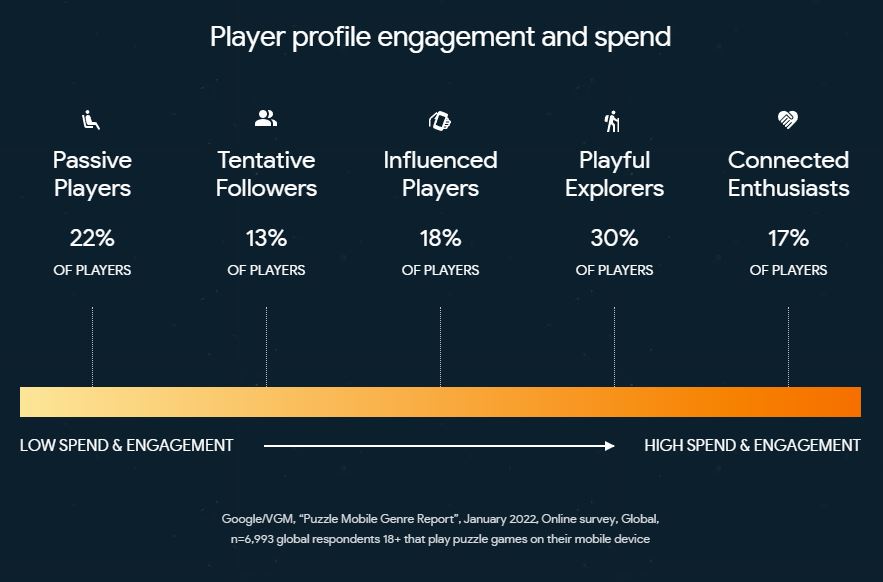
A major part of these groups even refuse to define these games just as an activity to pass the time, and they define themselves as gamers.
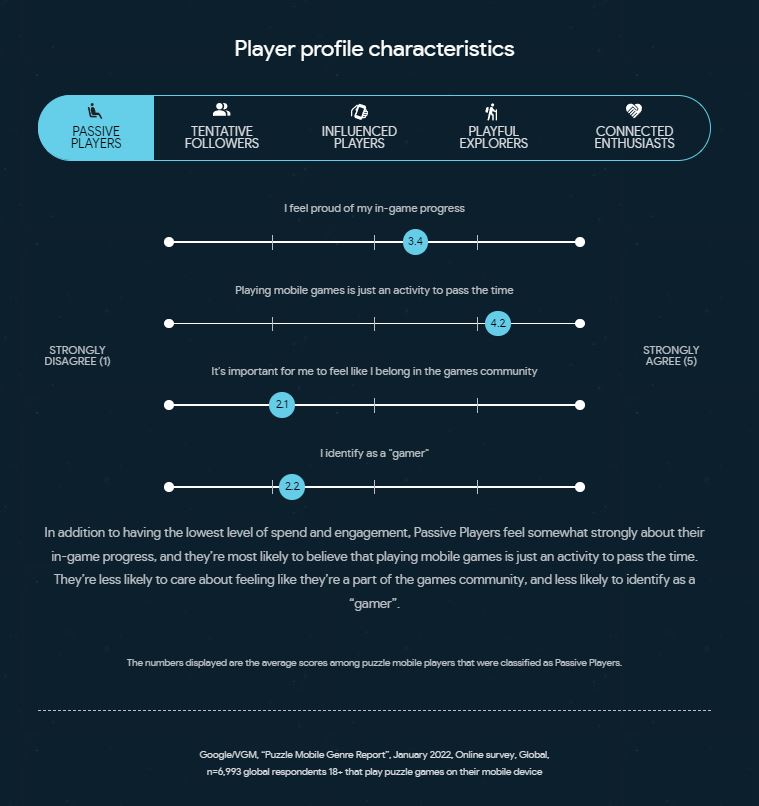
Reflected on the general audience of these games, these statistics present high engagement and loyalty rates, which is very important for the genre since most successful games in the genre are completely free to play and depend on ad revenue or in-game purchases.
While puzzle games are known for their simplicity, they cleverly incorporate a layer of challenge through escalating difficulty levels. As players progress, these games introduce increasingly complex puzzles that demand heightened skill and strategic prowess for completion. This challenge is captivating, ensuring the game experience remains engaging and dynamic. The gameplay’s simplicity entertains players and motivates them to enhance their skills, setting the stage for a continuous pursuit of higher scores and mastery of the game’s evolving complexity. Integrating difficulty levels adds depth to the overall experience, transforming what may seem straightforward into a journey of skill refinement and accomplishment for players.
Puzzle games are relatively quicker to develop and improve
Puzzle games embrace minimalist graphics and design elements. This design choice also enhances the efficiency of the game experience. Evading flashy and intricate visuals offers players a plain, focused gameplay free from distracting elements. But most importantly, these plain and minimalistic design choices make puzzle games easier to develop even for developers with limited resources, including workforce, time, and funds. This minimalistic approach also makes them suitable to be improved with live-ops. Therefore, a developer can create and launch a game, start monetizing it, and improve it with updates to reach a wider audience.
Considering all these factors, the future of puzzle games looks optimistic. Their popularity is rising on both the industry side and the audience side. The subgenre is anticipated to grow, and there are solid drivers for this growth, like the increasing number of smartphone users, technological advancements, and accessibility to high-speed mobile internet. But developers and publishers should keep adapting, innovating, and introducing unique, original products by utilizing their creativity.





